Apr
10
2009
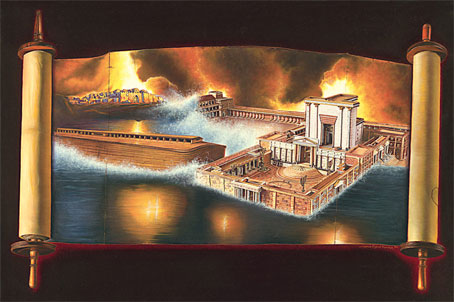
A couple of guys have written a book called Beyond Creation Science. As preterists, they understand there was a symbolic ‘flood’ across the Land of Israel under both Nebuchadnezzar’s Babylon and Nero/Vespasian’s Rome. Problem is, they read this back into Noah’s flood and try to say that this was only a local flood, which then allows them to compromise with old-earth Creationism.
It was ‘long-age’ geological assumptions that provided a ‘foundation’ for Darwin’s long-age biological fantasy. I would recommend Tas Walker’s site, Biblical Geology, for someone who really knows his stuff.
The position of these fellows causes more problems than it fixes. It makes the Bible’s very detailed chronology a joke, and forces a gap of millions of years into Genesis 1.
Here’s the solution:
Adam’s failure brought physical de-Creation. Cain founded a corrupt civilisation whose evil influence triumphed and was destroyed in a literal flood. Just like Cain, Ham was cursed, and his son Canaan’s influence led to social de-Creation. As God raised new land out of the waters after the flood, God would now perform another Creation miracle. In calling Abram, God was socially dividing the waters of the nations into the Land and the Sea. The era of the patriarchs, ruling fathers, began. God called Abram, and tore the world in two.
The land and sea division was a literal, physical land and sea in early Genesis. The ark of Noah was a literal ’world-in-a-box’, a safehouse and doorway to a new world. But when God called Abram, the ‘Land and Sea’ division was purely social, and the Tabernacle and Temple were a symbolic ‘world-in-a-box.’ These guys have confused these two and unwittingly undermined the authority of Scripture.
[Also, on hyperpreterist ‘Covenant Creationism’, see A Chronic Hysteresis.]
Comments Off | tags: Abraham, Against Hyperpreterism, Bible Chronology, Covenant Creationism, Temple, The flood | posted in Against Hyperpreterism, Biblical Theology, Creation, The Last Days
Apr
10
2009
The ark had three levels. The Lord divided three times to make His world, so it had three levels that required filling: sky, land and sea. In Exodus 20:4, three levels represent the entire universe. God forbids us to make an image of anything in the heavens above, the land below, or the waters under the earth.
God’s instructions for the ark included a window and a door, which match the “the windows of heaven” and “fountains of the deep.”
So the ark was a temporary model of the world, a sanitation-sealed miniature that was a door from the old world to the new one. In this way it prefigured the Tabernacle, the Temple, and the body of Christ. In Matthew 7, Christ’s parable of the wise man and the foolish man depicts one house saved (the ark) and another house destroyed by a flood (the old physical Temple). The entire Old Creation was judged or rescued in the ark/temple of Christ.
Comments Off | tags: Temple, The flood | posted in Totus Christus
Apr
10
2009
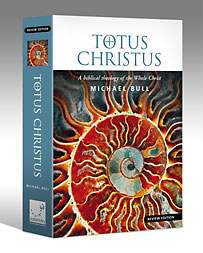 God uses symbols not only to reveal the spiritual character of physical people and events, but also to demonstrate their relationships to each other.
God uses symbols not only to reveal the spiritual character of physical people and events, but also to demonstrate their relationships to each other.
For instance, when Satan is called a serpent, it is because he is using the weapon of deceit, spewing it out of his mouth like counterfeit living water. When Satan is called a dragon, he is using the weapon of death, inciting a mob or government to kill God’s people.
The land and the sea are the physical land and sea in Genesis, but once God narrows His focus down to a priestly nation, Israel becomes the Land, and the Gentiles become the Sea. This demonstrates the boundary set by God between Jews and Gentiles. When Israel sins, the Gentiles rush in like a flood.
Comments Off | tags: Hermeneutics, Satan, The flood, Typology | posted in Totus Christus
Apr
8
2009
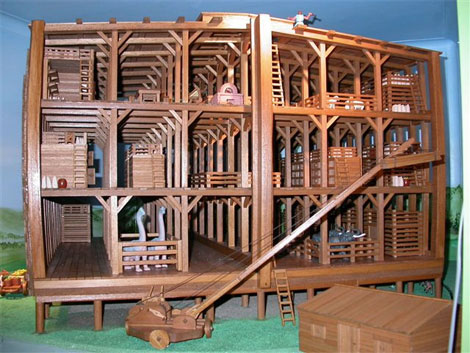
“God told Noah to build the Ark with nests inside. The word qen {kane} is translated nests every other time it appears in Scripture, but most versions substitute the word rooms only for Noah’s Ark. Since there is no good reason to do this, we should take nests as the preferred option. Thinking in terms of nests rather than rooms, we begin to see a different view of how the animals may have been housed…
As nests, it would be inappropriate to imagine animals lined up on display or herded together in huge stalls. Neither option would suit animal transport anyway. Instead, we should be thinking of snug, private enclosures where an animal would hide and bed down. The enclosure should be comfortable, safe, private, warm and probably darkened. It should also be an area that is not routinely disturbed.”
from www.worldwideflood.com
If the ark prefigured the Temple and the body of Christ, a floating “house” mediating between the old world and the new, the congregations within His body are “nests.”
Comments Off | tags: Noah, The flood | posted in Biblical Theology, Creation
Apr
8
2009
“As you saw iron mixed with ceramic clay, they will mingle (intermarry) with the seed of men; but they will not adhere to one another, just as iron does not mix with clay.” Dan 2:43
I think the key to Genesis 6 is that this pattern is repeated many times in the Bible. It was the sin of INTERMARRIAGE, of compromise between the priesthood and unbelieving women. Adultery and idolatry have a close connection. Continue reading
Comments Off | tags: Babylon, Compromise, Genesis, Herod, Temple, The flood | posted in Biblical Theology, The Last Days
Apr
8
2009
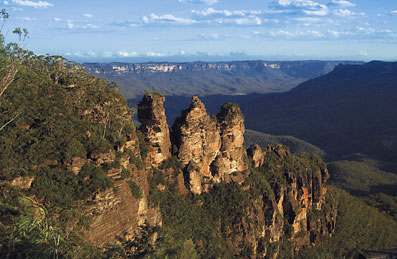
I live not far from one of Australia’s most popular tourist destinations, the Three Sisters. This rock formation overlooks a valley with spectacular sandstone cliffs. I climbed the Three Sisters a few years ago – when it was still legal!
Question is, is this valley the result of a little water over a lot of time, or a lot of water over relatively little time? If you look at the fine layers in the rocks, none of them shows any signs of being exposed for long before the next layer was put on top of it. No roots, burrows, etc. None of the disturbance by vegetation that you find at the top of the cliffs.
My friend, geologist Tas Walker, says:
Most visitors don’t realize they are looking at compelling evidence for the global Flood described in the Bible. The sandstone, of which the Sisters are made, points to huge watery deposition. The valleys and gorges, shaped when the Sisters were carved, are evidence of immense watery erosion. The Biblical global Flood explains this deposition and erosion…
You can read his full article here.
and make sure you check out his website, Biblical Geology.
Comments Off | tags: Geology, The flood | posted in Creation
Apr
8
2009
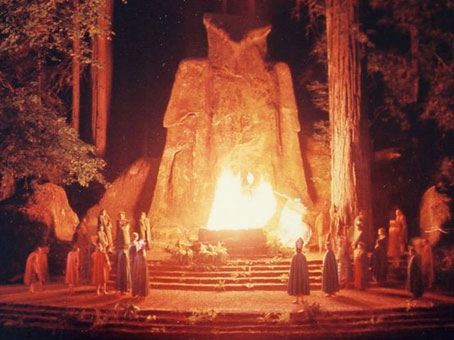 During the Creation week, there were three days of forming new “empty spaces” by dividing the original watery deep (the Abyss), then three days of filling them. A ‘world model’ develops with God’s throne at the top and the Abyss at the bottom, the place furthest from the throne. The architecture of the Tabernacle follows this model, laid out upon the ground.
During the Creation week, there were three days of forming new “empty spaces” by dividing the original watery deep (the Abyss), then three days of filling them. A ‘world model’ develops with God’s throne at the top and the Abyss at the bottom, the place furthest from the throne. The architecture of the Tabernacle follows this model, laid out upon the ground.
When the priesthood – the Land-mediators – disobeyed God, the Abyss was dredged up to cover the Land (holy place). We see this first in the flood, and later in the invasions of Assyria, Babylon and Rome.
The Valley of Hinnom became a symbol of the ‘Abyss’ below the true mountain of God. As an evil twin of the holy place, it was an ‘Adamic’ clay pit with no glorious metal. It was also the place where Judah sacrificed their infants to false gods. It was counterfeit worship in the tabernacle of hell, and the Lord said He would fill it with their bodies. Their dark ‘table of showbread’ became a snare. [Read Jeremiah 19]
After the Babylonian captivity, Zechariah saw the church in “the deep” (often translated valley or glen). A new Land-altar was rising out of the ‘waters’ – a new mountain of God, with a new Eden-temple to mediate for the world.
TAOTA
Comments Off | tags: Altar of the Abyss, Babylon, Creation Week, Exile, Gehenna, Jeremiah, Priesthood, Tabernacle, Table of Showbread, The flood, Zechariah | posted in Biblical Theology, The Restoration Era
Apr
8
2009
In the Sermon on the Mount, Jesus gave the pattern for a new Tabernacle. The sermon follows the pattern of the Tabernacle furniture, which in turn follows the pattern of the Creation week.1 At ‘Day 3′, Altar and Table, are His commands concerning Covenants (divorce and oaths), and the Lord’s prayer.
“Leave your gift there before the altar, and go your way. First be reconciled to your brother, and then come and offer your gift.” Matthew 5:24
Interestingly, these blessings are mirrored by the curses upon the saints’ evil twins in Matthew 23, the Jews who sat in Moses’ seat of judgment.2 The “woes” follow exactly the same pattern, and climax with Christ’s prophecy of the destruction of the Old Covenant Temple. And what do we find in this passage at Day 3?
Continue reading
Comments Off | tags: Altar of the Abyss, Daniel, Gehenna, Passover, Sermon on the Mount, Table of Showbread, Temple, The flood | posted in Biblical Theology, The Last Days
Apr
8
2009

or Hyperpreterism: stuck on the starting line
Hyperpreterists take great delight in pointing out the inconsistencies in what they refer to as “partial” preterism. Matthew 25 is a good example. If we are going to (rightly) interpret Matthew 23 and 24 as referring to the destruction of centralised worship (the old age) and the beginning of a new age of righteousness, surely Matthew 25 is within the same context?
On this one, I agree with the hypers. Matthew 25 is fulfilled… Continue reading
Comments Off | tags: Atonement, David Chilton, oikoumene, Postmillennialism, Revelation, The flood | posted in Against Hyperpreterism, The Last Days































